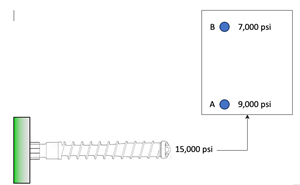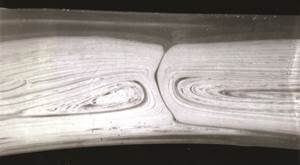INJECTION MOLDING: Properly Placing & Cooling Insulator Plates
Thermal-energy management from the mold to the platens is critical for making consistent parts.
As injection molding continues to evolve, more applications require polymers that meet high temperature and performance requirements. Often these materials require processing temperatures above 315 C (600 F) and mold temperatures more than 100 C (212 F). These polymers have numerous special requirements in processing, such as high melt viscosities that require 25,000 to 40,000 psi to fill parts, special drying requirements, and strict cooling regimens.
Here, I’ll focus on the problem of keeping the mold at the correct processing temperature without too much heat transfer to the platens of the molding machine. While this may seem like a minor issue in the scope of forming a plastic part, it does have significant impact on part tolerances, consistency, quality, and performance.
In processing these high-melt- and mold-temperature polymers, it is common to see that some problem develops after an hour or more of running production. Most processors understand that with a mold running at 175 C (~350 F) there is an issue of heat transfer to the platens. The greater the difference in temperature between two pieces of steel, the faster the rate of heat transfer.
To mitigate this, molders often place an insulator board or plate between the mold clamping plate and the platen. The insulator plate does help but it still has a thermal conductivity (K factor) of 2.1 Btu/hr/ft2/oF at 220 C (425 F). Heat transfer still occurs, but it takes more time. Platens often get so hot you cannot touch them or work on the mold. If we understand that the platens do indeed get hot and that they rarely have cooling lines, we can begin to see how and why problems develop.
Here’s a short list of the problems due to platen warming: As platens heat up, they expand. If the coefficient of thermal expansion for steel is ~1.1 x 10-5 in./in./oC or ~6.6 x 10-6 in./in./oF, and we have a platen that is 3 ft wide with a 75 F to 275 F temperature change, we have roughly a 0.0475-in. (1.2-mm) expansion. This can spread the tiebars farther apart, like a “Y”, which is likely to present resistance as the mold closes. This shows up as a mold-protection alarm on the machine.
Have you ever seen a clean parting line but the mold will not close after an hour or two of production on one of your hot molds? As the platens warm up they change in size and if they do not expand evenly, you can get wear on the parting line, the platen itself, and the mold—and don’t forget the tiebars.
You also have to think about how long it takes to achieve thermal equilibrium for a stable mold and process. Lots of time and money are lost as the process changes, and what was at one point a good process now produces bad parts.
The point is that heat transfer to the platens is an issue. Is there a better solution than just using insulator plates?
John Klees, a well-respected mold designer, suggests putting insulator plates between the mold and the clamping plate. Then gun drill the clamping plates for cooling and run 65°C (150°F) water through them to protect the platen, mold, and machine (see accompanying illustration).
Here are some benefits of this approach:
• Elimination of excessive heat transfer to the platens.
• Faster time to thermal equilibrium for mold, platens, and tiebars.
• Less wear and tear on the machine and mold.
• Platens will be warm but they can be worked on without burning your hands.
• Far less wait time before you can remove and handle the hot mold.
• Fewer wasted startup shots before you make consistent parts.
• A more stable process.
• Less waste of an expensive resin.
In short, for consistent processing and parts, thermal-energy management from the mold to the platens is critical. In my book, any mold running above 80°C (180°F) needs insulator plates between the mold and the clamping plates and the clamping plates should be water cooled. Also, ditch the hot-oil mold-temperature controllers and use the safer high-pressure water versions. The costs are well worth the benefits.
ABOUT THE AUTHOR: BOZZELLI
John Bozzelli is the founder of Injection Molding Solutions (Scientific Molding) in Midland, Mich., a provider of training and consulting services to injection molders, including LIMS, and other specialties. E-mail john@scientificmolding.com or visit scientificmolding.com.
Related Content
How to Set Barrel Zone Temps in Injection Molding
Start by picking a target melt temperature, and double-check data sheets for the resin supplier’s recommendations. Now for the rest...
Read MoreA Simpler Way to Calculate Shot Size vs. Barrel Capacity
Let’s take another look at this seemingly dull but oh-so-crucial topic.
Read MoreUnderstanding the Effect of Pressure Losses on Injection Molded Parts
The compressibility of plastics as a class of materials means the pressure punched into the machine control and the pressure the melt experiences at the end of fill within the mold will be very different. What does this difference mean for process consistency and part quality?
Read MoreWhat to Do About Weak Weld Lines
Weld or knit lines are perhaps the most common and difficult injection molding defect to eliminate.
Read MoreRead Next
Troubleshooting Screw and Barrel Wear in Extrusion
Extruder screws and barrels will wear over time. If you are seeing a reduction in specific rate and higher discharge temperatures, wear is the likely culprit.
Read MoreHow Polymer Melts in Single-Screw Extruders
Understanding how polymer melts in a single-screw extruder could help you optimize your screw design to eliminate defect-causing solid polymer fragments.
Read MoreLead the Conversation, Change the Conversation
Coverage of single-use plastics can be both misleading and demoralizing. Here are 10 tips for changing the perception of the plastics industry at your company and in your community.
Read More
.jpg;width=70;height=70;mode=crop)
















.png;maxWidth=300;quality=90)








